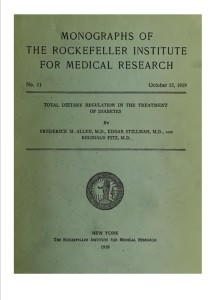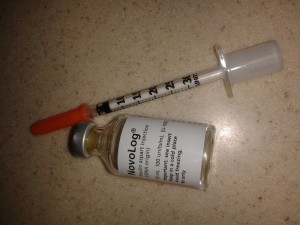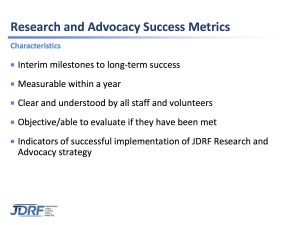My friend Sara guest blogged here back in August. She is part of JDRF’s T1D Voices Council and also my dear friend. Last week, she sent me an email about my blogging break, and attached a speech she wrote to present to the Board at her Tucson JDRF Chapter. She thought her presentation might work for a guest blog post and I’m thrilled she wants to guest blog yet again. So here it is and thanks Sara.
How Far Has Research Come, and Where Else Can it Go?
 “First, a little history lesson, if you will indulge me. Diabetes has been around a LONG time, first notated by Hippocrates, and on through the ages. A brief history of the disease is included in this monograph published in 1918. At different times, the ailment was thought to be a problem with the kidneys or the liver, or the blood, or the psyche. Proper diagnosis of diabetes became possible in the 1600s when Thomas Willis noted that the “urine is wonderfully sweet, as if imbued with honey or sugar,” as if he was describing a fine wine! The doctors and scientists were determined to find out what caused the fatal dis-function of the body, and endeavored to find better, more effective ways to treat it.
“First, a little history lesson, if you will indulge me. Diabetes has been around a LONG time, first notated by Hippocrates, and on through the ages. A brief history of the disease is included in this monograph published in 1918. At different times, the ailment was thought to be a problem with the kidneys or the liver, or the blood, or the psyche. Proper diagnosis of diabetes became possible in the 1600s when Thomas Willis noted that the “urine is wonderfully sweet, as if imbued with honey or sugar,” as if he was describing a fine wine! The doctors and scientists were determined to find out what caused the fatal dis-function of the body, and endeavored to find better, more effective ways to treat it. In the late 1700s, one treatment called for confinement to the house, preferably to one room, with the utmost possible quiet and avoidance of exercise. THAT I could live with. The diet however, called for milk and lime water, bread and butter, blood pudding, game and other rancid OLD meats and lots of fat. The skin was to be greased daily with hog’s lard, and flannel [GAH] was to be worn. Another called for the drinking of melted beef fat mixed with hot oil, and regular bleedings….In the mid 1800s, they threw out the rancid meat treatments in exchange for alcohol, (which works for me). Milk was forbidden, careful mastication was encouraged, and finally bleeding and opium treatments were condemned. About 150 years ago, improved techniques of research determined that it was the pancreas that was the offending organ, and with not-yet-invented-laser-like focus they began to study it, often in tandem with more and more rigid dietary restrictions. in 1911, a Dr. Hodgson advocated eating a raw egg with a few ounces of olive oil several times a day, and that’s it.
All that to say, thank GOD, I was diagnosed in April of 1974, when I could treat my diabetes with THIS  Though i must say this 30 unit syringe with its super fine needle is a lot more palatable than the 100 unit syringe with the pool cue sized needle I first used.
Though i must say this 30 unit syringe with its super fine needle is a lot more palatable than the 100 unit syringe with the pool cue sized needle I first used.
 Though i must say this 30 unit syringe with its super fine needle is a lot more palatable than the 100 unit syringe with the pool cue sized needle I first used.
Though i must say this 30 unit syringe with its super fine needle is a lot more palatable than the 100 unit syringe with the pool cue sized needle I first used. But had I been diagnosed a mere 60 years earlier in 1914, my parents would have been told that I had an almost 100% fatal disease, Like my great aunt Gigi, who was diagnosed in 1918, I may not have lived long enough to see the next christmas. If the high sugars didn’t do me in, i most likely would have died of starvation. For, as the monograph outlines in great detail, until 1922 and the discovery of insulin, the only way to stave off death was literally to starve the patient. As Dr. Allen wrote, “Expectations of an actual cure, in the sense of a restoration of the normal power of food assimilation will be disappointed under any dietetic treatment, and the need of some more potent therapy than diet is a keen stimulus to research.”
I think you get the point that research has never stopped on this disease. And that brings me to the point of this talk. I just got back from the annual Research Retreat held by the JDRF in New York, and never has Research been more important AND more productive. The first part of the meeting was the T1D Voices Council of which I am a member, along with 15 other voices from around the world, other T1Ds, medical professionals including our own Dr. Insel’s brother, several parents and even a grandmother. We reviewed some of the budget considerations of JDRF, and without going into the specific details and the way the funding is split up into different buckets, I can assure you that it DOES go to research that will lead to a Cure. We also discussed some issues JDRF faces with clinical trials and what the role of the individual is in terms of developing these. There are several places on line, including the JDRF web site, Medivizor and the National Institute of Health where you can go to enroll and be alerted when a trial comes up in your area…though there are not that many in Tucson.
Lastly, we thought it would be a GREAT idea if JDRF took the opportunity of the 100 year anniversary of insulin in 2022, to develop some clever, exciting marketing campaign. We felt it would great awareness and advocacy tool and hopefully, they can really put some effort into it.
It was then on the Research retreat where we got to sit in on the talks given by various researchers, the most interesting to me was that of Viacyte, a bio tech company in San Diego. We head from their lead researcher about this credit card sized thingie that will be implanted in the back and will ultimately offer 24 months of diabetes-free living. While JDRF is waiting for the clinical trials to go forward (Phase I and II begin next year, by the way), they are working with another company to develop the capsule materials. The encapsulated islet cells die without insulin so this other company has developed this material that is actually being incorporated into the body – I wish I had that slide, but you could SEE blood vessels growing in and around it…bringing blood to the islet cells
And it is partnerships like this that were the focus of another talk by Pure Tech – this is basically a Venture Capital Firm that, in partnership with JDRF have created T1D Innovations which “will accelerate the development of innovative T1D therapies and enhance our ability of turning Type One into Type None. Basically, T1D Innovations will create and fund companies to translate discoveries into products, helping them cross the well-known biomedical “valley of death” – which is the notorious gap that often prevents promising biomedical discoveries from being developed and reaching patients. T1D Innovations will develop new companies around promising scientific research, providing the infrastructure and resources that are necessary to advance the research to/and through clinical development and finally to the T1D community.
We also heard from a guy at Pfizer who talked about another collaboration between Pharma, academic science and JDRF. The upshot of that was that if, after all the study and research, Pfizer doesn’t want to invest to bring it to market, it reverts back to JDRF’s or the academic instuitutions control to find another way to bring it to the market, so some big pharmaceutical company is not going to discover our cure and then decide it isn’t WORTH the investment!
There is considerable research being done on restoring and rejuvenating islet cells which may someday lead to a vaccine that everyone gets, like the measles or polio vaccine. This would prevent the body from developing the disease in the first place, but in the nearer term, that very research will be used hand in hand with the encapsulation research.
Yes, the focus is definitely still on ending this disease. Some of the work being funded on islet and beta cell treatments, antibody treatments, smart insulin and especially the artificial pancreas, all point to exponential Improvements in treatments, eventual reversals and some day, the prevention of the disease world wide.
The official line from JDRF is that “The path forward from Type One to Type None is a continuum of therapies that leads to a cure. As our research programs and therapies move through the pipeline, new treatments will progressively remove the daily burden, side effects, and complications.”
German Pathologist, Bernhard Naunyn, said, “the therapy of diabetes has been well founded by painstaking labor, highly fruitful in all directions; we may be proud of that which has been achieved and yielded here…….” he wrote that in 1906, and I think it is still true.
We WILL turn Type One into Type None and on my and Errin and Brody and Aidan and Alecia and Nathanael’s behalf, not to mention everyone else, thank you for your support and belief in this organization!
Sara


I’ve been becoming increasingly involved with my local chapter of JDRF and it is so exciting to receive updates on research that someday will lead to a cure. But I also like their support for things like the Artificial Pancreas which will give T1’s better treatment options until there is a cure. Sara and Alecia, thanks for your involvement in JDRF!
thanks Alecia….Hope springs for me……